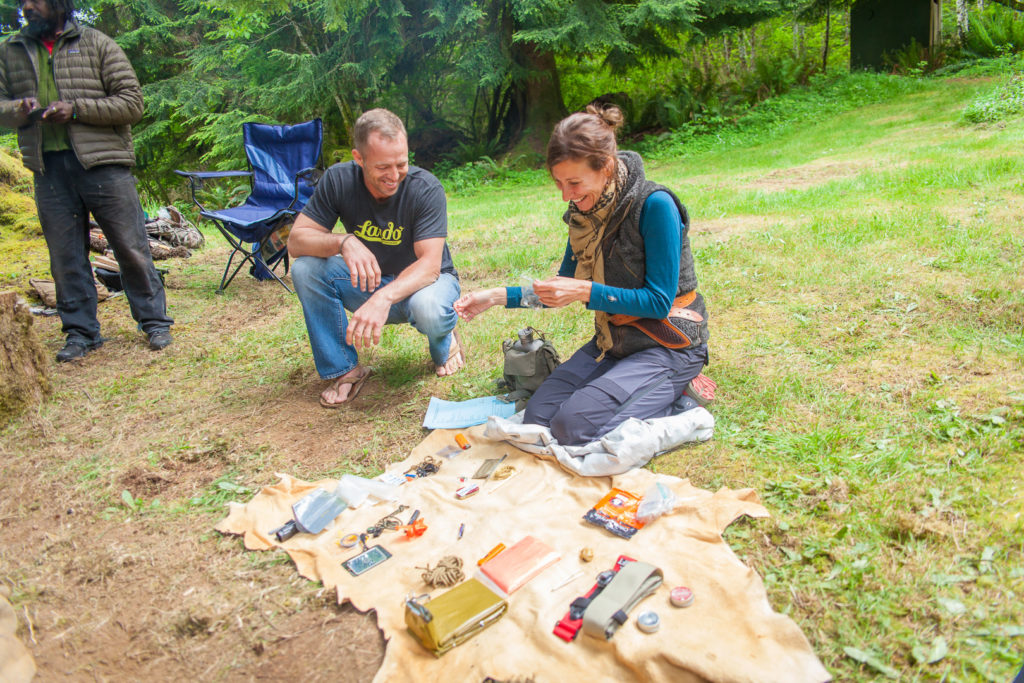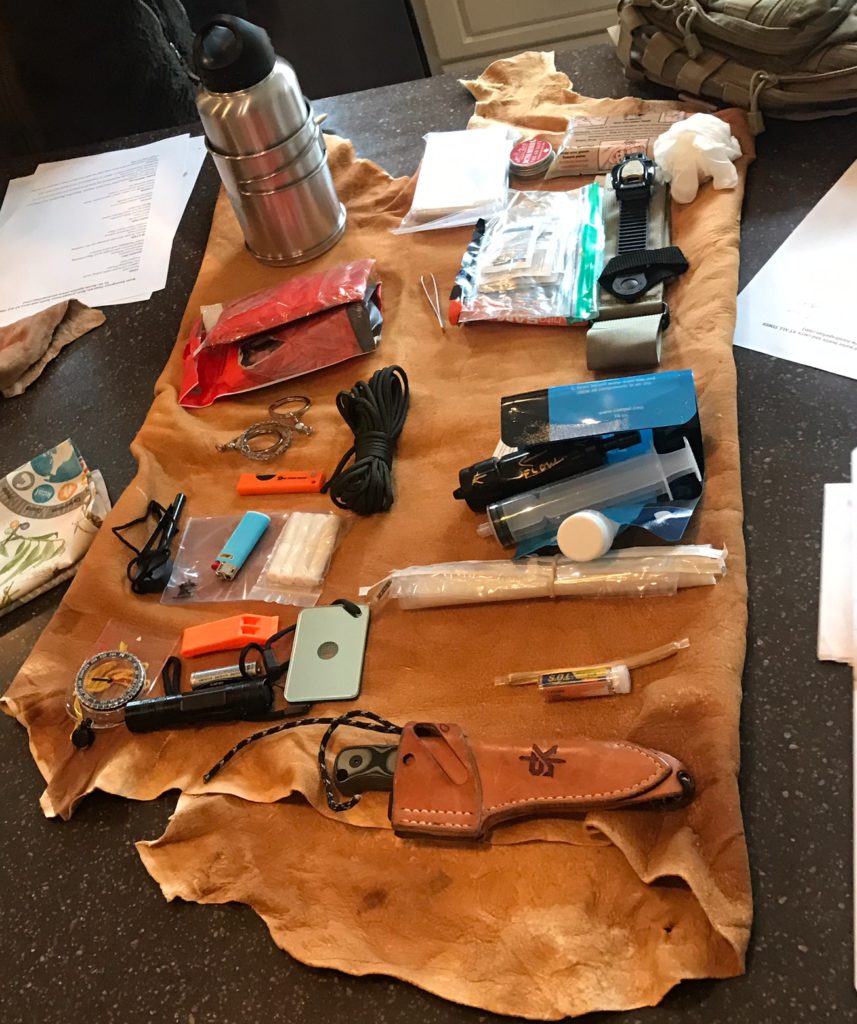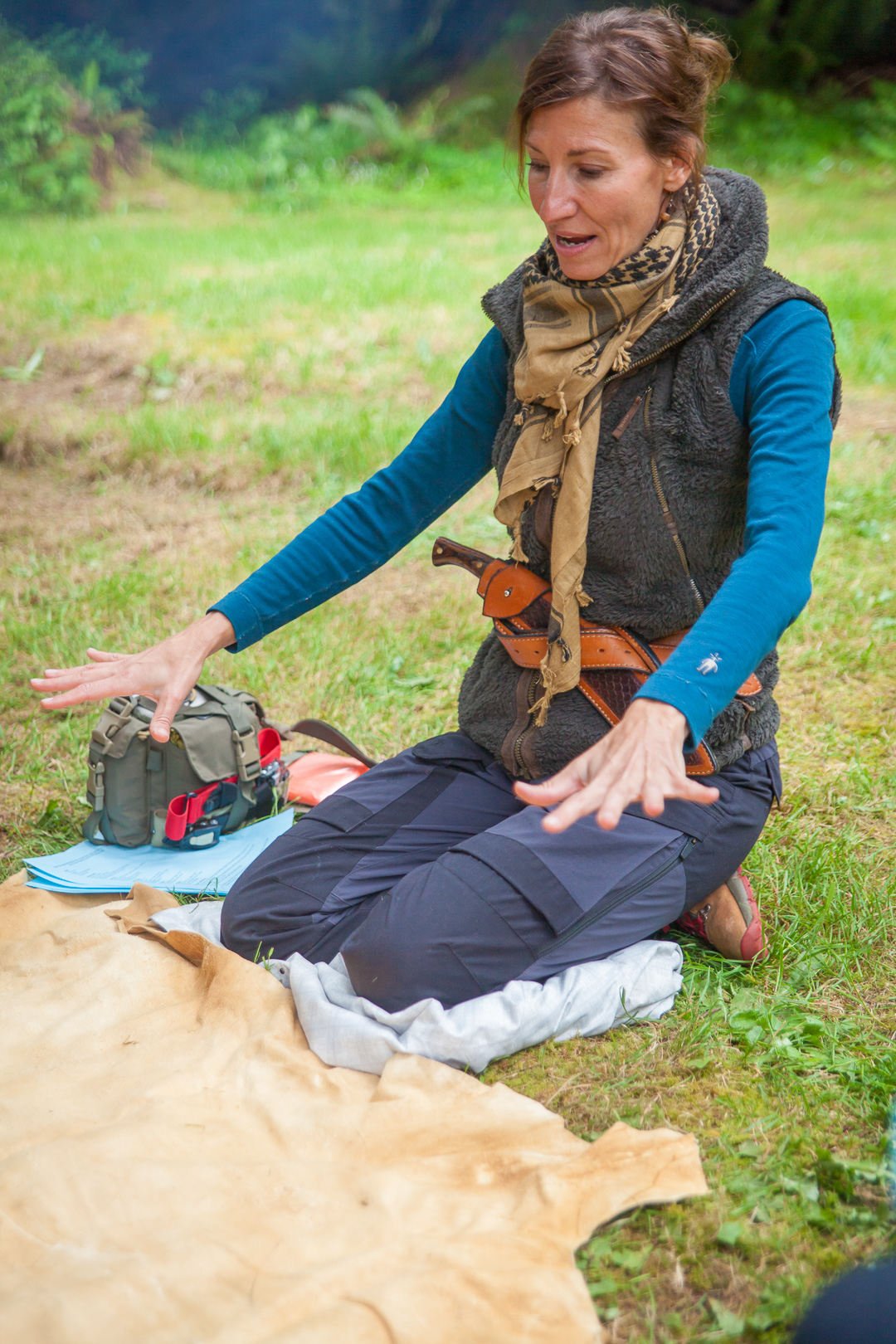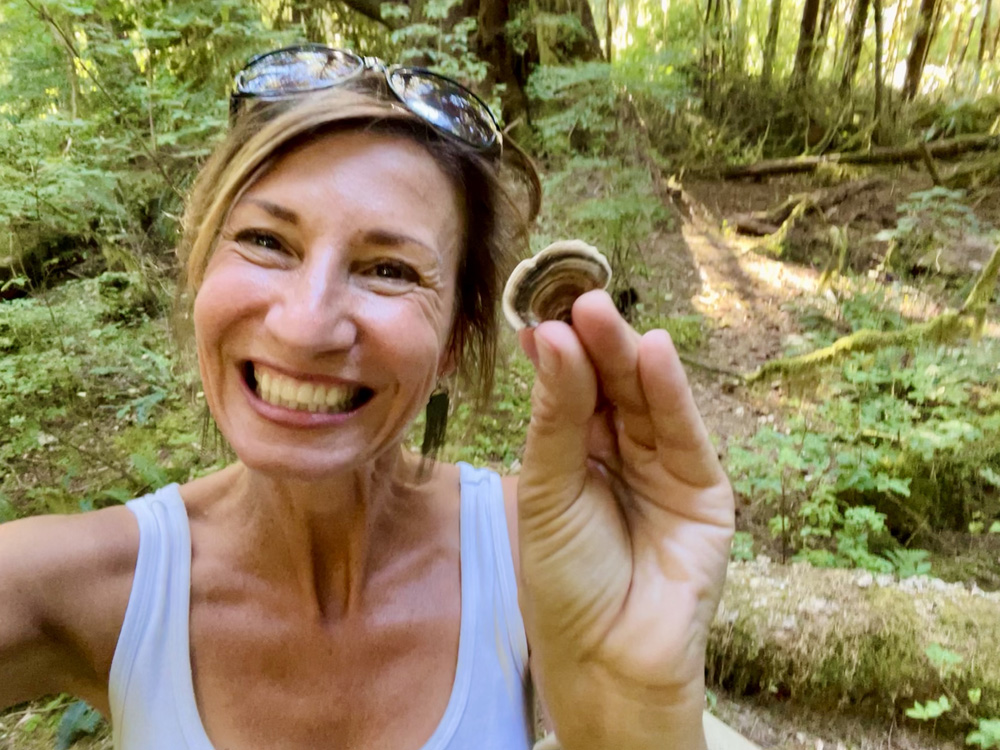There are a few things I keep on me AT ALL TIMES – I used all caps to really emphasize that I carry these items every day without exception. These are the items I would want to have on hand if I was stranded due to an accident or car breakdown, inclement weather, getting lost, or a natural disaster of some sort.
My Basic Emergency Field Kit is something you can essentially pull together yourself by using the links below, or if you’d like me to put a complete kit together for you (or for someone else as a gift) I’d love to do so. Complete kits are $489 plus $25 shipping within the USA. Just get in touch to order!
I’ve broken the items down into use categories to help give you context.
Basic Emergency Field Kit | FIRE:
Ferro Rod – this lightweight firestarter Ferro rod weighs less than 3 ounces and also includes a military-grade paracord lanyard, a multi-tool striker with a straight-edge spine, a concave tinder scraper, a map scale, a ruler, a hex wrench, and a bottle opener. Not sure how to use one of these? Here’s a quick video tutorial – you’ll see how easy it is to start a fire quickly and safely. It also works when wet, unlike a lighter.
Lighter – Grab this easy-to-find item anywhere and please remember to take OFF the child-safety device. In an emergency, you want to be able to get a flame fast.
Fire Starting Tinder – this fire starting tinder is made of long-burning, lightweight cotton and can be used with your Ferro rod to start a fire even in damp conditions.
Fresnel Lens – this two-pack of super-thin, super-lightweight PVC Fresnel Lenses should be standard equipment in your survival kit because they provide up to 4x magnification and double as a fire starter. Remember when you were a kid and trying to create a spark with a magnifying glass on a sunny day? Well, this is that very concept on a grown-up level. With dry tinder and some warm sunshine, you can easily light a fire. Plus, it helps make map-reading easy in case you don’t have your reading glasses on hand.
Basic Emergency Field Kit | SIGNALING:
Map Compass – This simple, lightweight map compass helps you clearly orient direction. A must have for everyone.
Emergency Whistle – another item that should be in every survival | field kit. This can help others track your location if need be, and because it’s ultra-loud can also help frighten away animals that may pose a danger.
Signal Mirror – I keep this ultralight signal mirror in my Emergency Field Kit because it is virtually unbreakable and can even signal when it’s overcast. It also floats if dropped in the water. I also like to keep a bright neon flag and/or clothing in my kit to signal for help.
Small Flashlight – you should always keep a small, bright flashlight (and an extra battery!) in your Emergency Field Kit.
Basic Emergency Field Kit | WATER:
Water Bottle Kit – This Stainless Steel Water Bottle Kit is great because it also comes with a nesting cup that you can use for boiling water and cooking.
Water Bags – collapsible, lightweight water bags to use for collecting and storing water.
Water Purification Tablets – these effervescent water purification tablets kill microorganisms in water within 30 minutes to prevent cholera, typhoid, dysentery, and other water-borne diseases.
Sawyer Mini Water Filter – you can never be too cautious when it comes to consuming water from an unknown source. This mini water filter is an important part of an emergency preparedness kit but is also great for hiking, camping, and international travel as it removes 99.99999% of all bacteria, such as salmonella, cholera, and E.coli; removes 99.9999% of all protozoa, such as giardia and cryptosporidium. This water filter comes with a drinking pouch but also attaches to standard disposable water bottles.
Basic Emergency Field Kit | SHELTER:
Paracord 16’ – this military specification paracord is a must for any emergency field kit. Use it to string up a makeshift tent or a ridgepole from tree to tree to create a solid space to lean branches against for a lean-to. I like the Titan Survivor Cord as it has a 620 tensile strength and includes fishing line, snare wire, and tinder inside the cord. Very multi-purpose!
Wire Saw – I love this stainless-steel wire saw from 5ive Star Gear because it’s compact, light, and it WORKS. Use this to cut branches for your lean-to shelter, or saw logs for your fire.
Emergency Rain Poncho – it’s one thing to be stranded, it’s entirely another to be stranded, cold, and WET. These disposable rain ponchos are big enough for adults and will help protect kids from getting soaked as well. Can also be used to reinforce your makeshift shelter.
Mylar Blanket – use this 100% wind and waterproof, sturdy, extra-thick mylar blanket as a tarp/emergency shelter, ground cloth, gear cover, or wrap it around yourself as it reflects 90% of your own radiated body heat to help keep you warm in even the harshest conditions.
Basic Emergency Field Kit | FOOD:
In a real short-term emergency, food is your lowest priority. You can go a long time without food (even though it might not be pleasant!) Medical, water, shelter, fire and signaling take precedence. Do keep extra food in your car though and if you have a medical reason for needing food regularly make sure to keep some with you; jerky and nuts or pemmican are good options. The two items below are “just-in-case” items for food procurement.
28 Gauge Brass Snare Wire and Fishing Line and Hooks – I like these kits because they are compact, lightweight, and there for an emergency.
Basic Emergency Field Kit | OTHER:
Mora Knife – keep this fixed-blade outdoor knife (with carbon steel blade) or similar in your emergency field kit.
Ceramic Knife – this tiny folding knife is made from ceramic, brass, and plastic with a stainless steel keychain and is designed to cut through cardboard, leather, fabric, cord, or meat. Also makes a great flint steel scraper.
Small Sewing Kit – no matter how well-prepared you are, it’s almost a law of nature that your gear will fail, or rip at the worst moment. This survival sewing kit contains everything you need to repair tents, tarps, leather, canvas, cotton, clothes, shoes, packs, and more.
It’s also always a good idea to have local area maps in your emergency field kit as well!
Basic Emergency Field Kit | BASIC MEDICAL:
For first aid, start with the basics like emergency medications (anti-diarrheal, aspirin, ibuprofen, Benadryl, etc.) please be sure to include a reasonable supply of your own prescription medication(s).
A few other basics to always have on hand in your emergency field kit: at least 3 band-aids, 2 butterfly band-aids, and some decent tweezers. I also always keep a complete but basic first aid kit in my car as well as a more extensive “bug out bag” in my car. (If you want to order one directly from me, get in touch!)
A good tarp is also essential to include in your car kit – I use this tarp from 5ive Star Gear (they have great products!) as is extra water, wool blankets, a shovel, a saw, an axe, warm clothes, and extra food. This article focuses on what to carry on you, but a good car kit is also essential. I’ll be posting an article specifically on what to include in a car kit, stay tuned!
Also, include the following in your emergency field kit:
First-Aid/All-Purpose Salve – I actually make this myself with locally sourced, wild and/or organic Yarrow, Arnica, Calendula, Plantain, Cottonwood Buds, Vitamin E, Lavender Essential Oil in Organic Olive Oil and Beeswax. You can purchase directly from me in my Apothecary. My First Aid Salve promotes the healing of cuts, scrapes, minor wounds, rashes, first degree burns, and bruising. It also provides pain relief, can reduce swelling, stops minor bleeding, eases bruising, and soothes diaper rash. The salve has antibacterial, anti-fungal, and anti-inflammatory properties. This is my #1 best seller for good reason!
SWAT-T Tourniquet – these tourniquets are latex-free and can be used as more than a tourniquet – also use on wounds as a pressure dressing or an elastic bandage. I actually carry the SWAT-T Tourniquet AND a RevMedX Tourniquet at all times.
Chito-Sam Bandage – these easy to use, 100% pure chitosan hemostatic dressings are 3-inch x 6-foot can be cut to size as needed and help control bleeding from wounds or lacerations within minutes.
All of the above items should fit into an easy-to-carry sling bag and everything should be removed from its packaging and be ready to go. Remember, if you don’t have it on you and ready, it won’t do you any good in an emergency. I keep mine in my car at all times and when I travel or go for a walk this bag comes with me!
My Basic Emergency Field Kit is something you can essentially pull together yourself by using the links and information I’ve provided above, but if you’d like me to put a kit together top to bottom for you (or for someone else as a gift) I’d love to do so! Complete kits in a ready to go bag are just $489 plus $25 shipping in the USA. Get in touch to order today!

Nicole Apelian Emergency Field Kit





